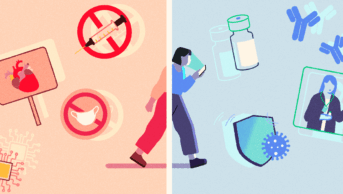‘Smoking Treatment Optimisation in Pharmacies’ (STOP) is a six-year programme funded by the National Institute for Health Research. STOP is a complex intervention based on behavioural theory, and involves training for pharmacy staff and associated study materials, such as badges and posters. The STOP trial is assessing the effectiveness and cost-effectiveness of the STOP intervention on smoker recruitment, retention and quit rates in the NHS stop smoking service based in community pharmacy. The trial is evaluating STOP in 30 control and 30 intervention pharmacies, with a primary outcome of smoker recruitment to the NHS stop smoking service.
Two STOP pilot studies were conducted in east London to test the STOP intervention training among community pharmacies providing the smoking cessation services. Conventional recruitment methods were used to recruit pharmacy staff, while Google was used to identify local pharmacies and an invitation letter was sent by post or email to STOP smoking advisors. The research team followed up with telephone calls and interested staff gave consent. In total, 18 pharmacies were recruited in both pilot studies. The pharmacies were either independent or small chain (those with less than five stores) pharmacies. The pilot trial failed to recruit many big chain pharmacies.
In the first pilot study, more than 50% of pharmacy staff were absent from the training session. STOP researchers discovered that they had no control over staff attendance at training, and a large number of pharmacy stop smoking services were in the process of being decommissioned by their local health authority.
These results informed changes to the recruitment approach, including the addition of a randomisation procedure before the main trial commenced. The STOP intervention was refined to accommodate all levels of pharmacy staff, and engagement with the local health authority was prioritised to signpost us to appropriate pharmacies. These changes led to the development of a novel approach to recruitment: an embedded recruitment ‘Russian doll’ model.
The Russian doll model divides the main stakeholders into four levels, beginning with the highest in the hierarchy:
- Commissioners;
- Community pharmacies that deliver STOP smoking services (pharmacy owner/decision maker);
- Pharmacy staff;
- Smokers.
The STOP randomised controlled trial aimed to recruit >5 commissioners, 60 communities pharmacies, >150 pharmacy staff and 1,200 smokers.
To begin recruitment, study synopses were sent to local commissioners (first level); this was followed up with a teleconference call with the STOP team, comprising the chief investigator, programme manager and clinical health psychologist. Prescreening was carried out by the local commissioners to eliminate potential decommissioned pharmacies, resulting in a reliably vetted final recruitment list.
The STOP research team sent the study information sheet to the pharmacy owner or the decision maker (second level) from the approved recruitment list, and followed up with a phone call. If the decision maker agreed to take part in the study, they gave consent during a site initiation visit and a clinical trial agreement was signed and dated. Once this research agreement was in place, the decision maker identified a small team formed by two to six members of staff (third level) from each participating pharmacy to join the STOP trial. Finally, consenting pharmacy staff members recruited smokers through their STOP smoking service (fourth level) to the trial on behalf of the research team.
Recruitment from large chain pharmacies required pre-approval from the company’s head office. The approved recruitment list was issued by the business development team, which contained 6–15 pharmacies. The STOP team initiated the recruitment procedure by contacting the branch manager as per Russian doll hierarchy guidelines.
STOP criteria were applied to ensure adherence to the Russian doll recruitment model: recruitment is discontinued if the chain in the Russian doll is broken; the embedded recruitment model works on the concept of hierarchy and the chain effect increases trial commitment among participating pharmacies and their staff. Criteria include:
- If a commissioner declines participation, no recruitment will be conducted in the associated borough;
- For pharmacy recruitment, if study participation is declined by the higher ranking ‘doll’ (pharmacy owner, for example) but staff are willing to take part, recruitment cannot progress;
- All staff participation required site manager approval before completing the informed consent procedure.
Subsequent research activities also followed the Russian doll model. For example, training invitations and dates were distributed to pharmacy staff by their decision maker. The pharmacy owner arranged staff cover to enable their team to attend weekday training. Pharmacy staff who attended training on Sunday received reimbursement for unsocial working hours. Currently, all pharmacies have completed intervention training, with an attendance rate of more than 90%.
The Russian doll model provides an effective way to recruit and manage staff participation in research. Using the model, 60 community pharmacies were recruited, as per protocol, and over 900 smokers have joined the STOP programme during a 16-month period. This embedded recruitment model yields all types of pharmacies, including big chains, which make up one-third of the cohort.
Wai Yee James, senior respiratory nurse;
Sandra Jumbe, researcher in psychology and primary care;
Colin Houlihan, research assistant;
Vichithranie Madurasinghe, statistician;
Stephanie Taylor, professor in public health and primary care;
Sandra Eldridge, professor of biostatistics;
Chris Griffiths, professor of primary care;
Robert Walton, professor of primary medical care;
All at Queen Mary University of London


